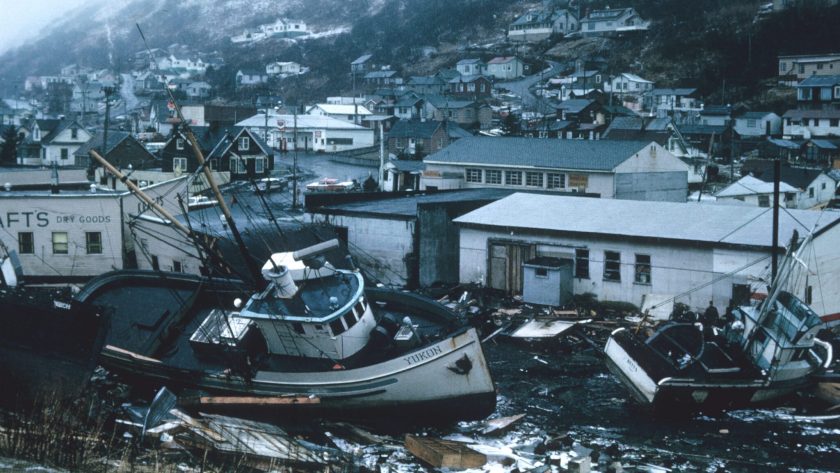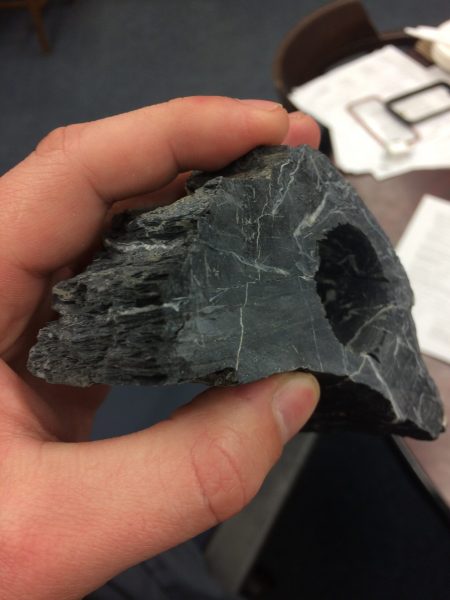Are Deep Fluids Behind the Largest Earthquakes? ‘Not So Fast!’ Says UT Graduate Student
December 6, 2021

Sandwiched between tectonic plates are layers of material that show up as thin shadows on seismic tomography, a kind of CT scan of the Earth. For years, scientists assumed the anomalies were signs of highly pressurized water squeezed into densely packed rock and that the fluid acted as a kind of hair-trigger on earthquake faults.
But a graduate student at The University of Texas at Austin has proposed an entirely different explanation: the seismic anomaly isn’t the result of pressurized water but rather ‘scars’ in the Earth.
The finding came when the student, Peter Miller, experimented on samples of such scars. He discovered that the rocks, which came from Kodiak Island, Alaska, had an inherent grain orientation different from the surrounding rock that would slow seismic waves when they struck at an angle.
“For decades people assumed that these slip zones are at elevated pore pressure,” Miller said, referring to the pressure of the water squeezed between rock grains at depth. “That’s not necessarily wrong, but we found that you don’t need high pore pressures to explain the decrease in velocity.”
The results, which were published in the journal Geophysical Research Letters in November, will help scientists, more accurately determine the conditions of the boundaries between plates where Earth’s largest earthquakes occur.

According to Miller, the scar-like pattern likely arose from the way certain rocks are forged. As one tectonic plate passes under another, clay-rich sediments from the ocean floor are drawn miles into the Earth. Simultaneously crushed, cooked, and dragged along by the moving plates, the material mineralizes, becoming dense and rock hard. The grains of the resulting material end up stretched and pointing in the same direction, creating a textured fabric that lets seismic waves pass rapidly when travelling along the grains, but slows them significantly when striking at a perpendicular angle.
The phenomenon, known as seismic anisotropy, only happens in certain types of rock and, importantly, is not accounted for in most interpretations of subduction zone earthquake faults, where one plate is pulled under another.
“The interpretation of these anomalous seismic wave speed signatures in subduction zones and the conditions that underlie earthquakes now need to be reevaluated,” said co-author Demian Saffer, director of the University of Texas Institute for Geophysics (UTIG). “Peter’s meticulous lab work and careful analysis shows that instead of fluids or pore pressure, the low seismic velocity may simply be caused by sheared, anisotropic rock.”
Miller was not planning on changing seismic interpretation when he started the research. He had intended to run stress tests on rocks exhumed from the Aleutian-Alaska subduction zone, where they were at one time buried along the plate boundary 12-15 km (around 7-10 miles) below.
The experiments, which recreated the force of a tectonic collision in the lab, were relatively straightforward: A vice squeezed chunks of rock in three opposing directions while bombarding it on one side with high-frequency sonic waves. A sensor at the other end listened for changes in the rock as pressure rose. When pressure reached about 1,000 atmospheres, grains and cracks in the rock aligned and muffled the sound in the same way high pore pressure would. The team then ran models of the deformed rock in computer simulations and found that the results matched real world seismic images. Because the Kodiak Island rocks are known to have once lain between the Pacific and North American plates, Miller and Saffer are confident the low velocity layers can be explained by deformed rock and not high pore pressure.
“The Eastern Aleutians are a really great spot to test this because they are dotted with outcrops of the relic accretionary prism,” Miller said, referring to the material that gets trapped between tectonic plates. “But does it work everywhere? Does it work in Japan, New Zealand or South America? Running these tests with rock samples from other major subduction zones would be an important next step.”
Miller began the research when he was a graduate student at Penn State before joining Saffer, his Ph.D. advisor, at UTIG. UTIG is a research unit of the UT Jackson School of Geosciences, where Saffer is also professor in the Department of Geological Sciences. The research was funded by the National Science Foundation’s GeoPRISMS program.
For more information, contact:
Constantino Panagopulos, University of Texas Institute for Geophysics, 512-574-7376
Anton Caputo, Jackson School of Geosciences, 512-232-9623.
This story was originally published by the University of Texas Institute for Geophysics.